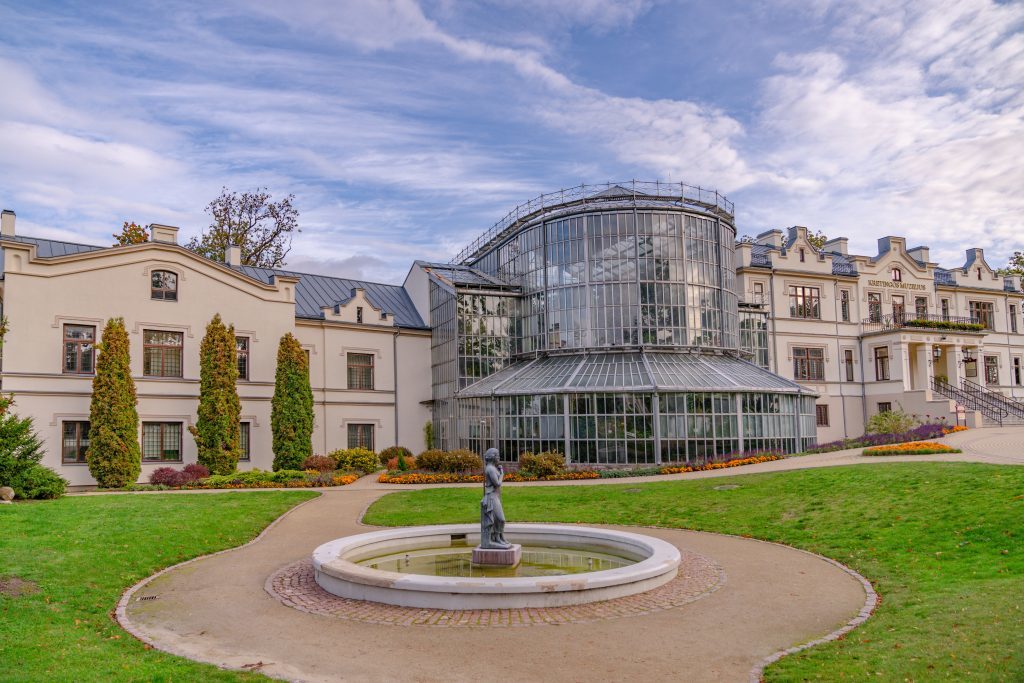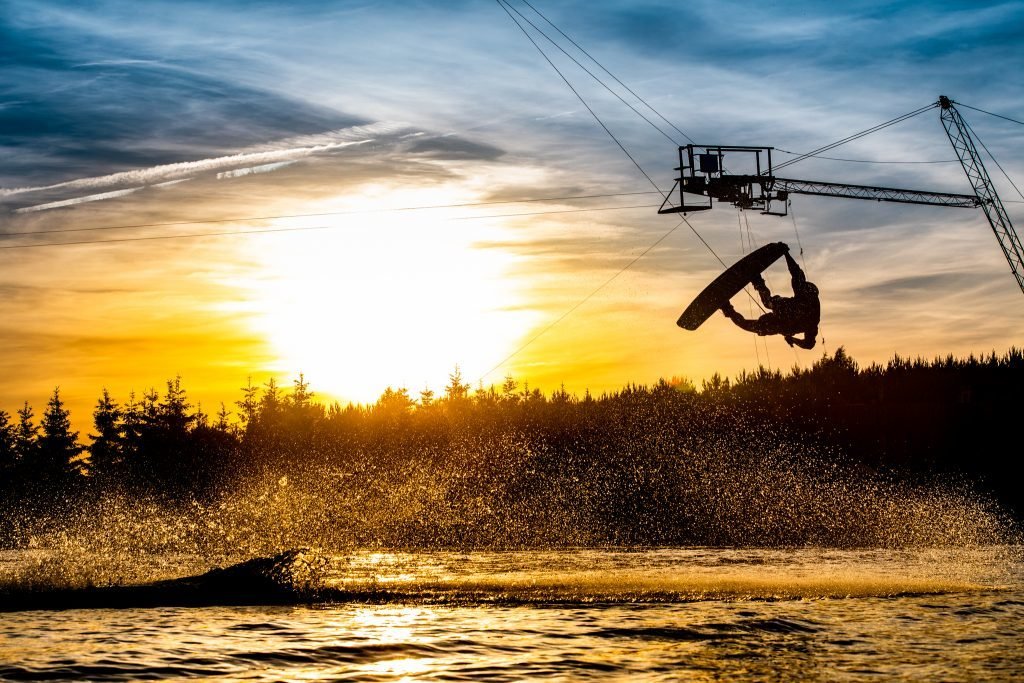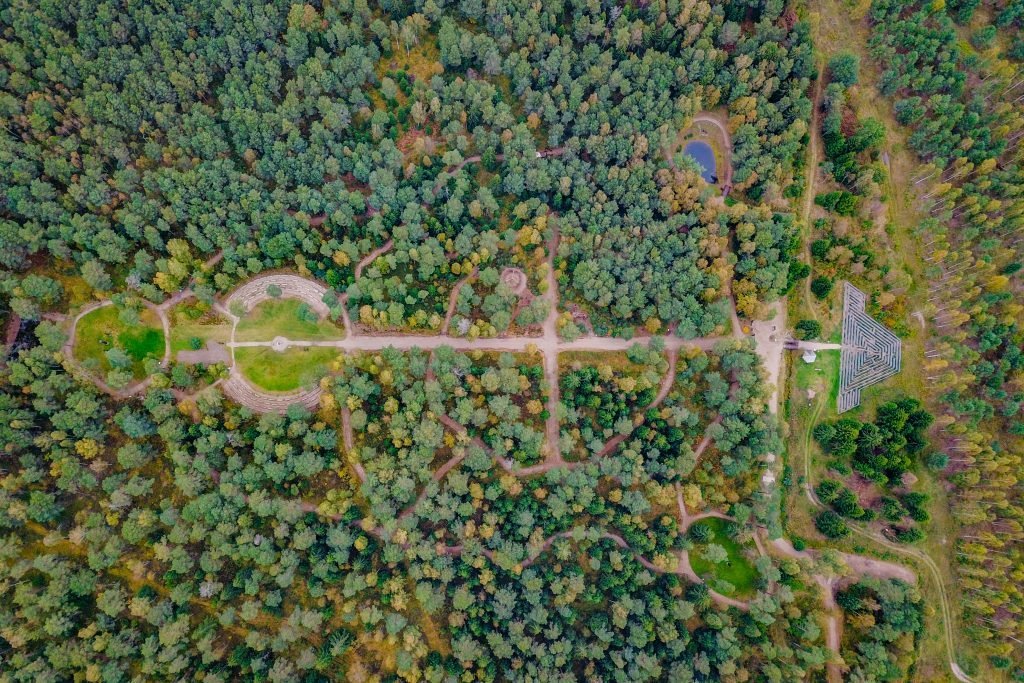Kretinga’s surroundings are distinguished by their rich history, gripping legends, heart-stopping nature, cultural and sacral heritage and facilities for active sports and health promotion.
To the manor: to see bananas growing and to bake bread

A major ornament to Kretinga city is the reconstructed Manor House and impressive Winter Garden of Counts Tiškevičius. The museum established in the Manor House presents a variety of archaeological treasures and works of art, as well as other exhibits. The Centre for Traditional Crafts operates next to it, where visitors are invited to bake traditional bread in a real antique bread oven and to make delicious caramel candies in the candy shop of the Manor. Visitors to the winter garden-conservatory will have an opportunity to admire 5,000 exotic plants, including real banana bushes, and perhaps even to smell the scent of the ripening fruit.
In the Manor park the sundial and astronomical calendar built in 2002 is composed of thirteen sculptures, symbolising the traditions of ancient Baltic culture, Lithuanian festivals, as well as significant dates in the history of Lithuania and Kretinga.
A promise converted into a monastery and a church
 Legend has it that J.K. Chodkevičius, a prominent military commander, promised before an important battle with the Swedes that, should he win, he would build a church in Kretinga. He won the battle, and a church, or rather a tiny wooden chapel, was erected in Kretinga. This angered J.K. Chodkevičius, who maintained that the church was to be magnificent and built of stone. Therefore, a stone church (currently the ensemble of buildings of the Franciscan Monastery and the Church of the Annunciation to the Blessed Virgin Mary) was erected soon afterwards on the bank of the Akmena River. It is one of the oldest churches with Gothic and Renaissance features in Samogitia. The miraculous altar of Saint Anthony stands in the church, and members of the Chodkevičiai family are buried beneath the central altar. Their sarcophagi are recognised to be items of cultural heritage.
Legend has it that J.K. Chodkevičius, a prominent military commander, promised before an important battle with the Swedes that, should he win, he would build a church in Kretinga. He won the battle, and a church, or rather a tiny wooden chapel, was erected in Kretinga. This angered J.K. Chodkevičius, who maintained that the church was to be magnificent and built of stone. Therefore, a stone church (currently the ensemble of buildings of the Franciscan Monastery and the Church of the Annunciation to the Blessed Virgin Mary) was erected soon afterwards on the bank of the Akmena River. It is one of the oldest churches with Gothic and Renaissance features in Samogitia. The miraculous altar of Saint Anthony stands in the church, and members of the Chodkevičiai family are buried beneath the central altar. Their sarcophagi are recognised to be items of cultural heritage.
It spins, but it isn’t a head. What is it?
 This is the motto of 313 Cable Park, the newest and most advanced wakeboarding park in Europe. And you can find it not in some distant European resort, but right here: in Užpelkiai, situated between Kretinga and Palanga. Founded by devoted fans of wakeboarding who have seen many places around the world, the park offers not just fun water rides, but overnight accommodation as well, and the Briusly Bar of the park invites you to come in for a gourmet snack.
This is the motto of 313 Cable Park, the newest and most advanced wakeboarding park in Europe. And you can find it not in some distant European resort, but right here: in Užpelkiai, situated between Kretinga and Palanga. Founded by devoted fans of wakeboarding who have seen many places around the world, the park offers not just fun water rides, but overnight accommodation as well, and the Briusly Bar of the park invites you to come in for a gourmet snack.
Baltic Mythology Park: what did our ancestors believe in?

The unique and rich worldview of our ancestors, the Baltic (Aesti) tribes, is visually represented at the Baltic Mythology Park near the town of Darbėnai. A trip to this distaff-shaped ucational park becomes engaging from the very first moment and allows you not only to see but also to ear the original Baltic understan -ding of the worldview and the connection between humanity and nature. Some visitors say that the park seems to be surrounded by some positive energy and they feel a wish to come back.
HBH: lots of funny activities and freely roaming animals
The name is known to nearly anyone who has ever come to the seaside for a holiday. Initially limited to catering and accommodation services, HBH has grown into a vast entertainment complex, featuring activities for both adults and children. Basketball courts, playgrounds for children, the Lūšies kelias (Path of the Lynx) adventure park, a wooden sculpture park, and Žvėrinčius, an enclosed area for domestic animals, where – what a lovely surprise! – a friendly llama or several sheep can pop up right behind you.
Japanese garden traditions featured in Samogitia

The Japanese garden, an integral part of Japanese culture, near the town of Darbėnai has been under development by Hajime Watanabe, a master from Japan, and Šarūnas Kasmauskas, a doctor, for over a decade. Though the garden started as an empty field, today it is the largest in Europe and covers an area of 16 ha. The garden features an impressive collection of bonsai trees, a rock garden with cherry trees and ponds. Matcha, Japanese green tea, can be enjoyed in the tea house. The most important experience in the garden is the feeling of harmony between nature and humanity.
Kartena hill-fort: a reminder of past wars

When driving through the township of Kartena, on the other side of the Minija River can be seen the Kartena hill-fort, once an important centre of the Ceklis land, and also known as the Castle, Swedes or Lūžtis Hill. Upon climbing the hill, one can admire the panoramic view of the township of Kartena. According to one of the legends, a castle of a Samogitian king once stood on that hill. The castle used to be frequently targeted by enemy troops. It so happened that the Swedish and Russian troops who came to attack the castle started fighting each other. The ruler of the castle exclaimed to his soldiers in the Samogitian language: “Veizėkiet, karė tenā!” (“Look, the war is there“). Thereafter, the place has been called Kartena.
Lazdininkai windmill: moved, bought and sold

The history of the Lazdininkai windmill will fascinate even those who have heard stories of all kinds. Prior to reaching Lazdininkai Village, the windmill stood in Padvariai, and before that even in our capital Vilnius! The octagonal wooden windmill was moved to Lazdininkai on the initiative of a pharmacist in Darbėnai. The structure was bought and sold several times, before eventually passing to a local farmer, who bought it for the money he had earned in the coal mines in America. It is now called a presidential windmill, as it belongs to the father of Gitanas Nausėda, the current President of Lithuania.
As many as 16 pools in the Atostogų parkas recreation complex
 The Atostogų parkas recreation complex is situated in Žibininkai, a bit further from the Palanga resort with its hustle and bustle. However, it is easily reachable by bike, using the bicycle paths. It is the largest recreation and wellness complex in the western Lithuania. The complex offers 16 pools, 7 saunas, a separate space for children and a variety of treatments and programmes to regain health and strength, all of which can be found under one roof and some even in the open air. The guests coming for a longer stay are offered accommodation in the hotel or in a log cabin surrounded by forest. Meals for visitors are offered by two cosy restaurants.
The Atostogų parkas recreation complex is situated in Žibininkai, a bit further from the Palanga resort with its hustle and bustle. However, it is easily reachable by bike, using the bicycle paths. It is the largest recreation and wellness complex in the western Lithuania. The complex offers 16 pools, 7 saunas, a separate space for children and a variety of treatments and programmes to regain health and strength, all of which can be found under one roof and some even in the open air. The guests coming for a longer stay are offered accommodation in the hotel or in a log cabin surrounded by forest. Meals for visitors are offered by two cosy restaurants.
Boom Park: for the mature and happy-go-lucky
 According to the founders of the Boom Park, it is a recreation park for everyone to be the person they wish to be or can be: a child, a mature personality or a happy-go-lucky fellow. There are plenty of attractions to make your head spin round: a crazy ride on a tire down the hill, or jumping on an ‘airbag’, or searching for luck in the maze, as well as having a try at various obstacle courses – why not! The summerhouses designed for quieter relaxation or personal celebrations are waiting for those who wish to spend their time in the open air, prepare food over a fire, and enjoy the pleasures of the sauna.
According to the founders of the Boom Park, it is a recreation park for everyone to be the person they wish to be or can be: a child, a mature personality or a happy-go-lucky fellow. There are plenty of attractions to make your head spin round: a crazy ride on a tire down the hill, or jumping on an ‘airbag’, or searching for luck in the maze, as well as having a try at various obstacle courses – why not! The summerhouses designed for quieter relaxation or personal celebrations are waiting for those who wish to spend their time in the open air, prepare food over a fire, and enjoy the pleasures of the sauna.
